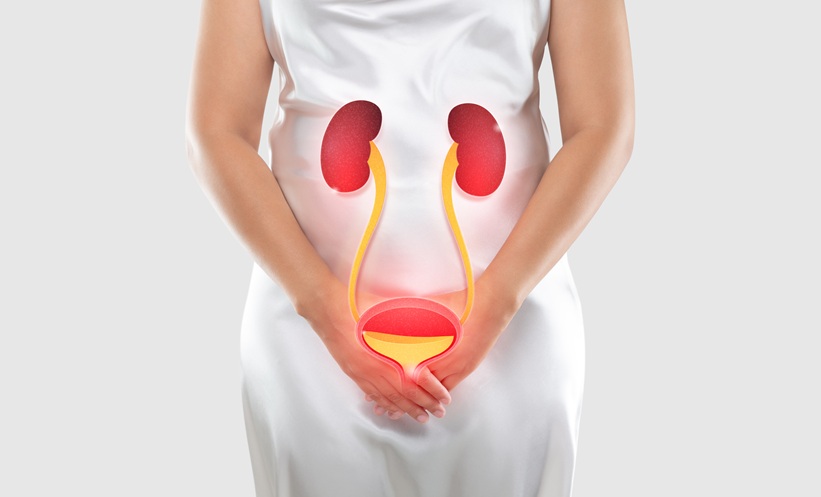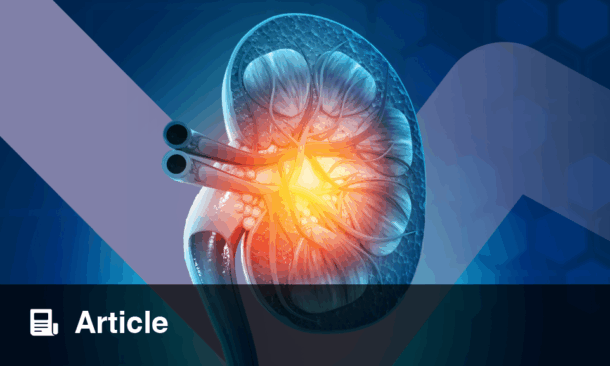Author: Aleksandra Zurowska, EMJ, London, UK
Citation: EMJ Nephrol. 2025;13[1]:23-27. https://doi.org/10.33590/emjnephrol/YKIN5558
![]()
B CELL TARGETING THERAPY
Kicking off the session with a talk on B cell targeting therapies, Jonathan Barratt, University of Leicester and John Walls Renal Unit, UK, explained that during that week, two major Phase III trials on B cell directed therapies reported their interim data, which, as Barratt explained, shows just how rapidly things are changing in the IgA nephropathy (IgAN) field.
When considering how to approach this complex, immune-mediated disease, Barratt explained the current focus for treating IgAN in line with the recent Kidney Disease: Improving Global Outcomes (KDIGO) guideline update. Firstly, as IgAN is a complex, immune-mediated glomerular disease, treatment requires specific approaches; symptoms often present late, when patients already have established chronic kidney disease (CKD) complications and, as such, need additional therapies to manage these.
IgAN immunology is characterised by the formation of circulating immune complexes. These can be measured in a laboratory to identify their protein constituents. Barratt noted that these complexes arise due to an overproduction of a particular form of galactose-deficient IgA1 (Gd-IgA1), which is thought to primarily derive from the mucosal immune system. Susceptibility to this is influenced by a complex genetic backdrop. Barratt also explained that multiple genome-wide association studies have revealed links between genetic risk loci and B cell activation pathways, supporting the rationale for B cell targeted treatments.
Once these immune complexes reach the kidney, they trigger a range of pathological responses. In particular, the mesangium mounts a pro-inflammatory reaction with mononuclear cell infiltration, complement activation, and, in more severe cases, crescent formation and fibrosis. These downstream effects amplify kidney damage and, as patients often present with symptoms late, leading to a late diagnosis, mean they often have significant nephron loss by the time they start treatment.
Barratt then outlined a conceptual framework for therapy, beginning with the need to reduce the formation of circulating immune complexes, followed by mitigating the inflammatory and fibrotic cascade triggered in the glomeruli, and finally, managing the broader complication of CKD. In an ideal world, clinicians would be able to intervene early, halting immune activity before any substantial renal damage is able to occur. However, given the current realities of diagnostics, these strategies often need to be employed concurrently.
Looking closer at immune-directed therapies, Barratt discussed several strategies to target the production of pathogenic antibodies. Budesonide, specifically a gut-targeted steroid formulation of budenoside, represents a novel way of modifying the mucosal immune environment. After being delivered to the terminal ileum, it suppresses IgA production at the source. Supporting this, Barratt showed data from recent trials, such as the NEFIGAN study,1 which has reported reductions in Gd-IgA1 and corresponding immune complexes without affecting total immunoglobulin levels.
Shifting focus to therapies directly targeting B cells and plasma cells, a key area of interest lies in the role of two cytokines, B cell activating factor (BAFF) and a proliferation-inducing ligand (APRIL), both of which are involved in B cell proliferation, survival, and class-switching to IgA. Barratt described numerous clinical studies that have shown that BAFF and APRIL levels are elevated in patients with more severe disease, making them promising therapeutic targets.
Barratt subsequently described a number of agents in development, such as the anti-APRIL monoclonal antibody, sibeprenlimab, which has shown proteinuria reduction in Phase II trials. He also noted the Phase III data from the VISIONARY trial reported at the Congress with similar findings.2 Another anti-APRIL agent, BION-1301, demonstrated Gd-IgA1 suppression and stable kidney function in 100-week data.3 Dual BAFF/APRIL inhibitors, such as telitacicept and povetacicept, also showed evidence of reduced proteinuria and slowed estimated glomerular filtration rate decline.4,5
Introducing another novel approach, whereby pathogenic IgA is directly removed from the circulation, Barrat discussed neonatal Fc receptor (FcRn) inhibitors, such as efgartigimod. This is currently used in myasthenia gravis, and may soon be adapted to target IgA. Additionally, new ‘IgA sweepers’ are being developed that bind and clear IgA via hepatic receptors. Although still in early development phases, these new strategies represent a different, cell-sparing approach to disease modification.
Barratt concluded his talk by reflecting on how far the field has come, from high-dose systemic immunosuppression to increasingly precise, targeted therapies informed by immunology, genetics, and oncology. He emphasised the need for patient-specific treatment plans, guided by a deeper understanding of disease mechanisms and therapeutic response.
DUAL RENIN-ANGIOTENSIN SYSTEM ENDOTHELIN INHIBITION
Continuing the session, Hiddo J.L Heerspink, University Medical Center Groningen, the Netherlands, took the stage to explore the role of endothelin receptor antagonists in IgAN management. This therapeutic strategy targets the non-immune, progressive drivers of CKD. Heerspink opened his talk with a polling question to gauge the clinical use of ERAs among the audience, none of whom had yet prescribed this treatment for IgAN, emphasising just how novel and underutilised this treatment approach is in routine practice.
Spotlighting the structural drivers of disease, Heerspink explained that, while B cell therapies may reduce inflammation, they are often insufficient alone, as many patients continue to lose nephrons due to glomerular hypertension, fibrosis, and vascular injury. These changes are largely driven by endothelin-1 (ET-1), a potent vasoconstrictor and pro-fibrotic molecule.
ET-1 is upregulated in response to kidney stressors such as aldosterone, angiotensin II, hypoxia, and oxidative stress. Once released, ET-1 binds to endothelin A (ETA) receptors, promoting mesangial expansion, interstitial fibrosis, podocyte injury, and ultimately, glomerulosclerosis. Whilst this has been known since the 1980s, clinical application was limited by side effects, particularly fluid retention and heart failure in patients with diabetes. Now, however, more selective ETA antagonists, lower dosing strategies, and careful patient selection are helping to address these concerns. Importantly, patients with IgAN, who are typically younger with fewer comorbidities, appear at lower risk of ERA-related fluid complications.
Heerspink continued by introducing three endothelin receptor antagonist-based therapies that have shown encouraging data in IgAN treatment: sparsentan, atrasentan, and SC0062. Sparsentan, a dual angiotensin II and ETA receptor antagonist, was tested in the PROTECT trial, where it reduced proteinuria by 43% compared to irbesartan.6 Crucially, this translated into a meaningful slowing of estimated glomerular filtration rate decline over 110 weeks, highlighted by a 9.5 mL/min loss in the irbesartan arm versus 5.8 mL/min in the sparsentan arm. A higher proportion of patients on sparsentan also achieved complete remission, defined as proteinuria below 0.6 g/day.
Atrasentan, a selective ETA antagonist, was studied in the ALIGN trial, which is ongoing but has already released interim data.7 Over 36 weeks, atrasentan achieved a 38% reduction in proteinuria compared to placebo, with effects visible within the first 6 weeks. These rapid changes suggest a strong haemodynamic effect, although, as Heerspink added, longer-term follow-up is needed to understand the full impact on inflammation and fibrosis.
Heerspink went on to note that this effect was consistent regardless of background sodium-glucose co-transporter-2 (SGLT2) inhibitor use, making atrasentan a promising candidate for combination therapy. He then introduced SC0062, a highly selective endothelin receptor antagonist currently in development. In a Phase II dose-finding study, the highest dose (20 mg) reduced proteinuria by 38% compared to placebo, with no signs of fluid retention, as measured by body weight or N-terminal pro B-type natriuretic peptide (NT-proBNP).8
Building on this, Heerspink highlighted the potential of combining endothelin receptor antagonists with SGLT2 inhibitors to maximise benefit while mitigating fluid retention. In the ZENITH trial, zibotentan plus dapagliflozin resulted in a 53% reduction in proteinuria, a statistically significant improvement over dapagliflozin alone.9 Bioimpedance analysis confirmed that dapagliflozin helped counteract the fluid-retentive effects of zibotentan, particularly at lower doses.
Turning briefly to real-world experience, Heerspink described that recent clinical observations from routine practice in Germany have indicated that sparsentan can deliver substantial reductions in proteinuria outside of a trial setting. Around one-third of patients were reported to have achieved complete remission, with most experiencing at least a 30% decline in proteinuria.
He concluded his talk by underlining the importance of considering endothelin receptor antagonists as a viable strategy in IgAN, not only as adjuncts to immune-modulating therapies, but also as standalone options for those with high proteinuria and low inflammation.
COMPLEMENT INHIBITORS
Closing the session, Claudia Seikrit, RWTH Aachen University, Germany, explored complement inhibition in IgAN and the role of complement activation in driving inflammation and progressive kidney injury. Beginning by looking back at the disease’s history, she noted that Jean Berger’s original description of IgAN in 1968 already mentioned complement deposits alongside mesangial IgA, something now understood as central to the disease mechanism.
Seikrit explained that complement activation, particularly via the alternative and lectin pathways, contributes to the clinical hallmarks of IgAN, including haematuria, proteinuria, and progressive glomerular damage. Of particular relevance is the alternative pathway, which is continuously active and requires strict regulation. When dysregulated, it can trigger a harmful cycle of complement amplification, driving mesangial and tubulointerstitial inflammation.
Turning to therapeutic targets, Seikrit outlined several points along the cascade currently under investigation: factor b and factor d (early activators), and the central components C3 and C5. She emphasised the importance of balancing efficacy with safety, particularly as the complement system plays a vital role in host defence. As such, prior to initiating any complement-directed therapy, vaccination against encapsulated organisms such as Meningococcus and Pneumococcus is mandatory.
Iptacopan, a selective, oral, factor b inhibitor, featured prominently at the Congress. Data from the Phase III APPLAUSE trial showed a 38% reduction in proteinuria after 9 months, with no significant increase in infections or serious adverse events.10 Seikrit also noted that cemdisiran, an RNA interference therapy that reduces hepatic production of C5, achieved a 37% proteinuria reduction, alongside improvements in haematuria and a favourable safety profile in a recent trial.11
Ravulizumab, a monoclonal antibody targeting C5 that is already in use for other complement-mediated conditions, also showed promise in IgAN. In the SANCTUARY trial, it reduced proteinuria by 30–40% over 26 weeks, and patients switching from placebo to treatment achieved similar benefits, again without major safety concerns.12
In closing, Seikrit underlined that complement inhibition offers a new therapeutic avenue in IgAN, particularly for patients with active inflammation or refractory disease. With several agents now progressing through late-stage trials, she suggested that complement-targeted treatments could soon become part of routine care, especially if supported by biomarker-driven patient selection and long-term safety data.
CONCLUSION
Together, these presentations highlighted a rapidly evolving field, with B cell therapies, endothelin receptor antagonists, and complement inhibitors offering promising and increasingly targeted options for managing IgAN.
As more data emerge, the challenge ahead lies in refining patient selection, treatment sequencing, and long-term disease control.





